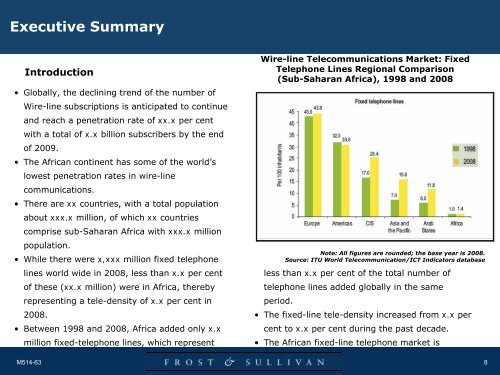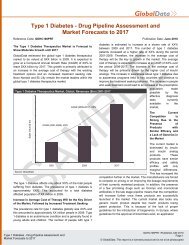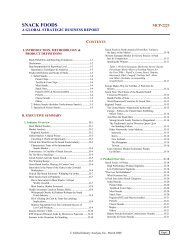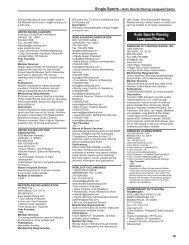View sample - Report Buyer
View sample - Report Buyer
View sample - Report Buyer
Create successful ePaper yourself
Turn your PDF publications into a flip-book with our unique Google optimized e-Paper software.
Executive Summary<br />
Introduction<br />
• Globally, the declining trend of the number of<br />
Wire-line subscriptions is anticipated to continue<br />
and reach a penetration rate of xx.x per cent<br />
with a total of x.x billion subscribers by the end<br />
of 2009.<br />
• The African continent has some of the world’s<br />
lowest penetration rates in wire-line<br />
communications.<br />
• There are xx countries, with a total population<br />
about xxx.x million, of which xx countries<br />
comprise sub-Saharan Africa with xxx.x million<br />
population.<br />
• While there were x,xxx million fixed telephone<br />
lines world wide in 2008, less than x.x per cent<br />
of these (xx.x million) were in Africa, thereby<br />
representing a tele-density of x.x per cent in<br />
2008.<br />
• Between 1998 and 2008, Africa added only x.x<br />
million fixed-telephone lines, which represent<br />
M514-63<br />
Wire-line Telecommunications Market: Fixed<br />
Telephone Lines Regional Comparison<br />
(Sub-Saharan Africa), 1998 and 2008<br />
Note: All figures are rounded; the base year is 2008.<br />
Source: ITU World Telecommunication/ICT Indicators database<br />
less than x.x per cent of the total number of<br />
telephone lines added globally in the same<br />
period.<br />
• The fixed-line tele-density increased from x.x per<br />
cent to x.x per cent during the past decade.<br />
• The African fixed-line telephone market is<br />
8
Executive Summary (Contd…)<br />
Introduction (Contd…)<br />
stagnating, and this is constraining fixed<br />
broadband growth.<br />
• The number of fixed broadband subscribers was<br />
xxx,xxx in 2008, thereby representing a<br />
penetration rate of x.x per cent in comparison<br />
with x.x million mobile broadband subscribers.<br />
• While the number of fixed-line Internet<br />
subscribers was x.x million, representing a<br />
penetration of x.x per cent in 2008 due to the<br />
low ownership (x.x per cent) of computers.<br />
• In sub-Saharan Africa, the number of fixed-line<br />
subscribers was x.x million, representing a teledensity<br />
of x.x per cent in 2008.<br />
• While the number of fixed Internet subscribers<br />
was xxx,xxx, representing a penetration rate of<br />
less than x.xx per cent in 2008.<br />
• Since the boom in Africa’s telecommunications<br />
market has taken place mainly in the mobile<br />
sector, the African wire-line operators could<br />
M514-63<br />
Wire-line Telecommunications Market: Fixed<br />
Broadband Region Comparison (Sub-Saharan Africa),<br />
2000-2008<br />
Note: All figures are rounded; the base year is 2008.<br />
Source: ITU World Telecommunication/ICT Indicators database.<br />
potentially become less attractive to investors.<br />
• Africa is lacking in investment-intensive infrastructure,<br />
such as fixed telephone lines and fixed broadband.<br />
• These indicators are low in comparison with the world<br />
average of xx.x per cent and xx.x per cent for the<br />
penetration of fixed telephone lines and Internet<br />
connection, respectively.<br />
9
Executive Summary (Contd…)<br />
Introduction (Contd…)<br />
Wire-line Market Development<br />
• Regulatory authorities also often favour<br />
incumbent fixed-line operators, who have<br />
problems to make profits, over new entrants,<br />
and this limits competition and private<br />
investment into fixed-line segment.<br />
• Traditional fixed-line telecommunications<br />
operators generate huge revenue streams, but<br />
are under pressure to expand network coverage,<br />
develop innovative data services and improve<br />
customer services.<br />
• The market participants used to be in the<br />
different tier of competition and/or part of value<br />
chain has started to offer similar lines of product.<br />
• For example, both cable and telecommunications<br />
operators offer fixed-line voice, broadband and<br />
video services.<br />
• Next Generation Network (NGN) is becoming the<br />
future technology of choice. This offers<br />
customers high-quality, converged and Internet<br />
Protocol (IP) -based services on one network.<br />
• In future, sub-Saharan Africa is expected to<br />
witness consolidation in its telecommunication<br />
sector as operators vie for the lower end of the<br />
market to help sustain robust growth.<br />
M514-63<br />
10
Executive Summary (Contd...)<br />
Introduction (Contd…)<br />
Wire-line Telecommunications Market: Undersea Cables Map (Sub-Saharan Africa), 2008<br />
Source: http://manypossibilities.net<br />
M514-63<br />
11
Executive Summary (Contd...)<br />
Introduction (Contd…)<br />
Undersea Cables<br />
• Several current and planned fibre projects will<br />
not only deliver high-capacity bandwidth to<br />
Africa, but also boost competition in the wire-line<br />
market and reduce costs of telecommunication.<br />
• However, expensive satellite services will<br />
continue to play a significant role in reaching<br />
Africa’s extensive rural and remote areas, where<br />
the majority of low-income group resides.<br />
• On the west coast, five submarine cable projects<br />
(Glo-1, WACS, MAIN One, ACE ,SAFE, SEA-ME-<br />
WE.3, and Atlantis-II) are under development.<br />
• Glo-1 has landed in the west coast in September<br />
2009 and WASC will land by the end of 2009.<br />
• MAIN One and ACE are expected to land in 2010<br />
and 2011, respectively.<br />
• On the east coast, the first fibre-optic submarine<br />
cable (SEACOM) went live in July 2009. Other<br />
three undersea cables (TEAMS, EASSy and<br />
Uhurunet) are expected to be operational along<br />
the east coast by the end of 2010.<br />
• These undersea cables will provide high-speed<br />
fibre optic connectivity at lower costs.<br />
• The whole sale tariffs of telecommunication<br />
services range between $x,xxx and $xx,xxx for<br />
SAT3 undersea cable and between $x,xxx and<br />
$x,xxx for satellite connection.<br />
• By the end of 2009, these tariffs will start<br />
declining to be within the range of $xxx and<br />
$x,xxx after Glo-1 undersea cable went live in<br />
the west coast, thereby representing an average<br />
cost reduction of xx.x per cent.<br />
• Besides better international networks, inland<br />
backbone terrestrial links will be needed and<br />
retail prices will have to come down once benefit<br />
of the wholesale price reduction is passed down<br />
to the end users.<br />
M514-63<br />
12
Executive Summary (Contd...)<br />
Introduction (Contd…)<br />
Undersea Cables (contd…)<br />
• In 2008, Africa as a whole had around xx Gbps<br />
of international bandwidth, and this corresponds<br />
to less than one-third of India’s total<br />
international connectivity.<br />
• On an average about xx.x percent of<br />
international broadband traffic volume are<br />
contributed by corporate users. The price of<br />
broadband services is likely to decline between<br />
xx and xx per cent.<br />
• Small and medium-sized enterprises (SMEs) may<br />
realise a cost reduction of xx per cent due to<br />
their relatively low usage of broadband services<br />
than corporate users, thereby increasing their<br />
ability to stay profitable.<br />
M514-63<br />
13









